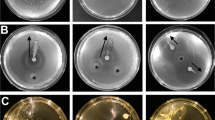Abstract
SINCE nematodes extracted from soil usually comprise a mixture of species, the isolation of a pure species population for experimental purposes is frequently a laborious procedure involving the picking of individual specimens from a suspension. The tendency of Tylenchorhynchus martini Fielding 1956 (Nematoda, Phasmidia) in aqueous suspensions to swarm (congregate in masses) has been used to obtain large numbers of this nematode relatively free of other species. In a series of tests, mixed populations of T. martini and other nematodes were extracted from soil around rice plants and incubated overnight in aqueous suspensions in Petri plates. The resultant masses of T. martini were observed under a dissecting microscope, carefully removed with a suction pipette and transferred to a small quantity of water in an Ehrlenmeyer flask. The nematodes were dispersed by shaking and then transferred to water in Petri plates for re-incubation. This procedure has been repeated several times with no apparent loss in swarming intensity, although about 5 per cent of the population of T. martini in each test does not swarm and is lost in subsequent transfers. Suspensions of 50–100 thousand nematodes of 70–80 per cent T. martini have been purified in two serial swarmings to more than 99 per cent T. martini, with a virtual elimination of organic and mineral debris. Factors which stimulate swarming include a high proportion of active T. martini in the mixed population and a suspension density such that the individual nematodes of this species are in contact in a shallow aqueous layer. A range of room temperatures and of water reactions varying from pH 3.5 to 7.5 have not influenced swarming intensity.
This is a preview of subscription content, access via your institution
Access options
Subscribe to this journal
Receive 51 print issues and online access
$199.00 per year
only $3.90 per issue
Buy this article
- Purchase on Springer Link
- Instant access to full article PDF
Prices may be subject to local taxes which are calculated during checkout
Similar content being viewed by others
Author information
Authors and Affiliations
Rights and permissions
About this article
Cite this article
HOLLIS, J. Induced Swarming of a Nematode as a Means of Isolation. Nature 182, 956–957 (1958). https://doi.org/10.1038/182956b0
Issue Date:
DOI: https://doi.org/10.1038/182956b0
This article is cited by
-
Phenomenon of Swarming in Nematodes
Nature (1966)
-
Nature of Swarming in Nematodes
Nature (1962)
Comments
By submitting a comment you agree to abide by our Terms and Community Guidelines. If you find something abusive or that does not comply with our terms or guidelines please flag it as inappropriate.



